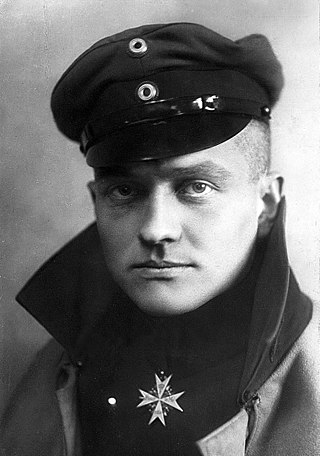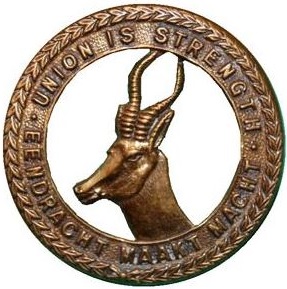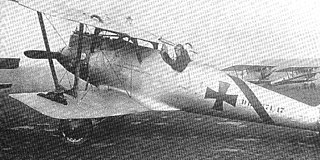
Manfred Albrecht Freiherr von Richthofen, known in English as Baron von Richthofen or the Red Baron, was a fighter pilot with the German Air Force during World War I. He is considered the ace-of-aces of the war, being officially credited with 80 air combat victories.

Frank Luke Jr. was an American fighter ace credited with 19 aerial victories, ranking him second among United States Army Air Service pilots after Captain Eddie Rickenbacker during World War I. Luke was the first airman to receive the Medal of Honor and first USAAS ace in a day. Luke Air Force Base, Arizona, a United States Air Force pilot training installation since World War II, is named in his honor.

Field Marshal Jan Christian Smuts, was a South African statesman, military leader and philosopher. In addition to holding various military and cabinet posts, he served as prime minister of the Union of South Africa from 1919 to 1924 and 1939 to 1948.

A flying ace, fighter ace or air ace is a military aviator credited with shooting down five or more enemy aircraft during aerial combat. The exact number of aerial victories required to officially qualify as an ace is varied but is usually considered to be five or more.

Carla Speed McNeil is an American science fiction writer, cartoonist, and illustrator of comics, best known for the science fiction comic book series Finder.

The Ritz Paris is a hotel in central Paris, overlooking the Place Vendôme in the city's 1st arrondissement. A member of The Leading Hotels of the World marketing group, the Ritz Paris is ranked among the most luxurious hotels in the world.
The following lists events that happened during 1942 in South Africa.

The South African Overseas Expeditionary Force (SAOEF) was a volunteer military organisation in World War I.

The following are lists of World War I flying aces. Historically, a flying ace was defined as a military aviator credited with shooting down five or more enemy aircraft during aerial combat. The term was first used by French newspapers, describing Adolphe Pégoud as l'as, after he downed seven German aircraft.

The Ritz-Carlton Hotel Company, LLC is an American multinational company that operates the luxury hotel chain known as The Ritz-Carlton. The company has 108 luxury hotels and resorts in 30 countries and territories with 29,158 rooms, in addition to 46 hotels with 8,755 rooms planned for the future.

The Clemenceau Case is a 1915 American silent drama film written and directed by Herbert Brenon and costarring Theda Bara and William H. Shay. The film is based on the French novel L'affaire Clémenceau, by Alexandre Dumas, fils, and is now considered to be lost.

OberleutnantAlexander Tahy was a Hungarian World War I flying ace credited with eight aerial victories while serving with the Austro-Hungarian Aviation Troops. He began the war as an artilleryman, winning the Silver Medal for Bravery in May 1915. In early 1916, he transferred to aviation duty as an aerial observer. Between 3 December 1916 and 26 June 1917, he was credited with five aerial victories for Fliegerkompanie 19, earning another three decorations. Having taught himself to fly, he transferred to a fighter unit, Fliegerkompanie 51J for his last three victories. On 7 March 1918, Tahy died in a flying accident. His greatest honor came after his death, when he was awarded the Knight's Cross of the Order of Leopold with War Decorations and Swords.

Tomorrow at Seven is a 1933 American pre-Code mystery comedy film directed by Ray Enright and written by Ralph Spence. The plot sees a group of people gathered in an old mansion being menaced by a killer known as "The Black Ace".

Royal Prussian Jagdstaffel 10 was a World War I "hunting group" of the Luftstreitkräfte, the air arm of the Imperial German Army during World War I. Jasta 10, in its brief existence, was credited with 118 enemy planes and 33 enemy observation balloons destroyed. In turn, it would lose twenty killed in action, another killed in a flying accident, ten wounded in action, and four held as prisoners of war.

Royal Prussian Jagdstaffel 12 was a World War I "hunting group" of the Luftstreitkräfte, the air arm of the Imperial German Army during World War I. As one of the original German fighter squadrons, the unit would score 155 aerial victories during the war, at the expense of seventeen killed in action, eight wounded in action, and one taken prisoner of war.
Royal Prussian Jagdstaffel 27, commonly abbreviated to Jasta 27, was a "hunting group" of the Luftstreitkräfte, the air arm of the Imperial German Army during World War I.
Captain Sydney Tyndall Liversedge was an English World War I flying ace credited with 13 aerial victories.

During World War I, the national air services involved developed their own methods of assessing and assigning credit for aerial victories.













